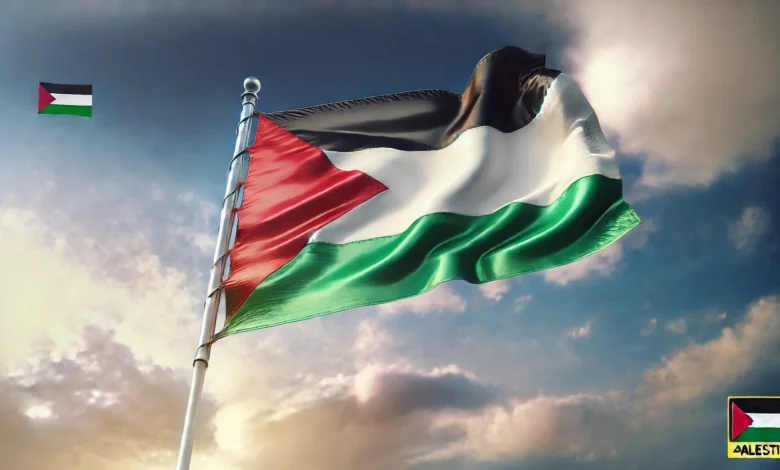The Palestine Flag: A Symbol of Identity, Resistance, and Hope

The Palestine flag stands as a powerful symbol of national identity, resistance, and the enduring hope for peace and self-determination. For decades, it has represented the aspirations of the Palestinian people, resonating with millions around the world who stand in solidarity with their cause. But what’s the story behind this iconic flag? In this article, we’ll explore its history, design, significance, and the role it plays today in representing a people’s struggle and pride.
The History of the Palestine Flag
Origins of the Design
The design of the Palestine flag traces back to the early 20th century. It was inspired by the flag of the Arab Revolt, which took place during World War I (1916-1918). The Arab Revolt flag symbolized the collective uprising of Arab nations against the Ottoman Empire. The Palestine flag, with its similar design, was officially adopted in 1964 by the Palestinian Liberation Organization (PLO) as the emblem of Palestinian nationalism.
Historical Milestones
The flag has witnessed significant moments in Palestinian history. It first gained international recognition during the 1960s, when the PLO was established to advocate for Palestinian rights. Following the Oslo Accords in the 1990s, the flag became widely accepted as the official flag of the Palestinian Authority, representing Palestine in various international forums.
Symbol of Unity and Resistance
Throughout its history, the Palestine flag has united Palestinians across different regions and political affiliations. Whether flown in refugee camps, displayed at protests, or waved during international events, the flag embodies a shared identity and the collective yearning for freedom.
The Design and Meaning Behind the Flag
Colors and Their Significance
The Palestine flag features four colors: black, white, green, and red, each carrying deep historical and cultural significance.
- Black: Represents the Abbasid Caliphate and the resilience of the Palestinian people.
- White: Symbolizes peace, hope, and the Umayyad Caliphate.
- Green: Stands for prosperity, the Fatimid Caliphate, and the Islamic heritage of the region.
- Red: Represents the sacrifices made in the struggle for freedom and the Hashemite dynasty.
Design Layout
The flag consists of three horizontal stripes (black, white, and green) and a red triangle on the hoist side. The triangle points towards the right, symbolizing progress and the forward momentum of the Palestinian cause.
Connection to the Pan-Arab Colors
The flag’s colors are part of the Pan-Arab palette, which is shared by several other flags in the Middle East, including Jordan, Kuwait, and Sudan. This connection reflects the broader Arab identity and the historical ties among Arab nations.
The Role of the Palestine Flag in Modern Times
A Global Symbol of Solidarity
In recent years, the Palestine flag has transcended borders, becoming a global symbol of solidarity. It is frequently seen at protests, rallies, and international events advocating for Palestinian rights. The flag’s presence sends a powerful message of unity and support for the Palestinian struggle for justice and self-determination.
Cultural and Political Significance
The flag is not just a political symbol but also a cultural one. It appears in Palestinian art, literature, and music, reflecting the deep-rooted connection between the flag and the Palestinian identity. Politically, it serves as a reminder of the unresolved issues surrounding the Israeli-Palestinian conflict and the ongoing quest for peace.
Controversies and Challenges
The Palestine flag has also faced challenges and controversies. In certain contexts, its display is restricted or even banned, leading to debates about freedom of expression and the right to national symbols. Despite these challenges, the flag remains a powerful tool for raising awareness and rallying support for the Palestinian cause.
How the Flag is Used in Daily Life
In Palestine
Within Palestine, the flag is a ubiquitous presence. It adorns government buildings, schools, and public spaces. During national holidays and significant events, it is prominently displayed as a symbol of pride and resilience.
Among the Palestinian Diaspora
For the millions of Palestinians living in the diaspora, the flag is a cherished symbol of their heritage and connection to their homeland. It is often displayed during cultural events, family gatherings, and moments of remembrance, serving as a bridge to their roots.
In International Advocacy
Activists and organizations around the world use the Palestine flag to amplify their message. It is a staple at protests, marches, and solidarity events, helping to draw attention to the Palestinian struggle and rally international support.
The Flag as a Source of Hope
Despite the challenges faced by the Palestinian people, the flag continues to be a source of hope. It represents not just the current struggle but also the vision of a future where Palestinians can live in peace, dignity, and sovereignty. For many, the flag embodies the belief that justice and self-determination are achievable goals, inspiring continued efforts towards these aspirations.
Conclusion
The Palestine flag is more than just a piece of fabric—it’s a powerful emblem of identity, resistance, and hope. Its rich history, meaningful design, and enduring presence in global discourse make it a symbol that resonates far beyond Palestine’s borders. Whether flown in the streets of Ramallah, waved in international protests, or cherished in the hearts of the diaspora, the flag continues to inspire and unite those who stand for justice and peace.
FAQs
1. What do the colors of the Palestine flag represent?
The colors symbolize different historical and cultural elements: black for resilience, white for peace, green for prosperity, and red for sacrifice.
2. When was the Palestine flag officially adopted?
The Palestine flag was officially adopted by the Palestinian Liberation Organization (PLO) in 1964 as a symbol of Palestinian nationalism.
3. Is the Palestine flag recognized internationally?
Yes, the flag is recognized internationally, especially after the Oslo Accords, and it is used in various international forums representing Palestine.
4. Why is the Palestine flag controversial in some places?
In some regions, displaying the flag is seen as a political statement and may be restricted due to the ongoing Israeli-Palestinian conflict.
5. How does the Palestine flag connect to other Arab nations?
The flag shares the Pan-Arab colors with several Middle Eastern countries, reflecting a shared cultural and historical identity.




